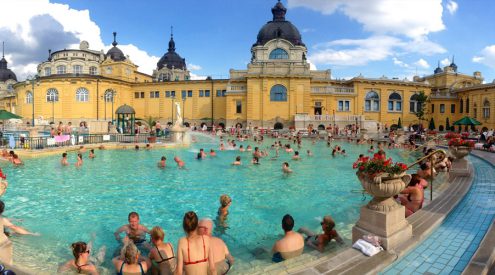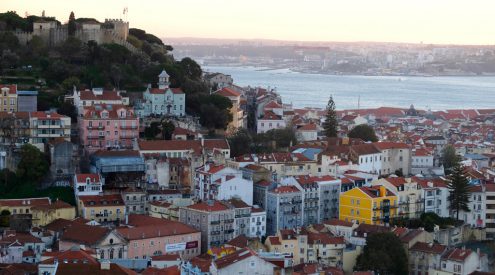I revisited Belfast in northern Ireland recently on a titanic mission – to see the new Titanic Quarter set right in the Belfast docks where “the Queen of the Seas” was built in the early 1900s. The highlight of my travels was the brand-new Titanic Belfast museum which opened to mark the centenary of the sinking of Titanic in April 1911.
Opened a hundred years later on 31 March 2011, the iconic landmark – shaped like a series of ship’s hulls to represent the logo of the White Star Line – was built at a cost of 97 million pounds (almost 1,5 billion rand). It has attracted 500 000 visitors over the first eight months, making it one of the big five tourist attractions in Ireland.
Standing at the exact height of the Titanic from keel to top deck, the high-tech museum looms over Belfast like the Opera House over Sydney. Two giant cranes used to build the Titanic – Goliath and Samson – are landmarks in Belfast harbour – along with the incredibly deep dry dock, pump house and slipway where she began her ill-fated journey. I watched the actual launch on an old black and white movie on a giant screen. An eye witness said “She took to the water as if she were eager for the baptism”.
I spent a whole morning lost in legend in the Titanic Belfast museum. A virtual reality ride takes you on a dizzying journey through the massive Arrol gantry and scaffolding where 10 000 workers put together the Titanic hammering three million glowing rivets. Interactive displays in eight galleries spread across five floors explore the social history of Belfast, a boom town founded on textiles called Linenopolis in the19th century, the history of these famous shipyards, and the legend of the Titanic.

Visitors experience the tragedy of the Titanic step by step, from the sounds and sights of the fit out, the sea-trials to France and the UK, the maiden voyage, and all the horror of the sinking and rescue – told in the terrified voices of actual survivors. Standing in a dark museum room, watching images of the sinking ship in the freezing waters of the North Atlantic, the end of the doomed voyage is terrifyingly real.
The last moments of the Titanic are related minute by minute down to the chilling SOS sent out at 12:15am on 15 April 1912 – “We have struck an ice-berg.” Experiencing the sinking through the eyes of survivors is a moving experience – the stories of heroism and the rescue. Novelist Thomas Hardy wrote ominously, “As the smart ship grew in stature, grace and hue, in shadowy silence grew the iceberg too.”

The poignant tale of the Titanic has captured people’s imagination for a century. Many movies have been made about it over the years – depicted in a collection of lurid movie posters. One of the fascinating exhibits explores all the myths and legends of the Titanic – from the locked binocular cabinet in the wheelhouse, the lifeboat shortage, the lowering of half-empty lifeboats, the quality of the rivets and design faults in sealed bulkheads to whether a cursed Egyptian mummy was onboard! Did the champagne bottle break at the launch (an ill-omen)? Did the owners ever claim the Titanic was unsinkable? True or false? Titanic buffs will find all the answers here!
The museum journey culminates with the discovery of the shipwreck over the last three decades. A glass floor reveals images of the wreck below your feet – while a submersible on a giant screen films the rusty steel “icicles” called rusticles.
The museum occasionally opens the top floor – a convention and functions space – which has a replica of the iconic first-class staircase complete with banisters. You can do high tea on the Titanic on Sunday in the first-class style – and pose on the staircase! We had lunch in the Titanic Bistro. I chuckled when the waitress asked me if I wanted ice in my lemonade! The locals say they built the ship not the ice-berg!
I was fascinated to learn there was no laundry on board the Titanic. She took enough linen for the whole voyage. The provisions showed they took on board 250 barrels of flour, 2500 pounds of sausages, 40 000 eggs (and live hens), 800 bundles of fresh asparagus, 438 gallons of ice-cream, 15 000 bottles of ales and stout and 8000 cigars!
The names of the passengers are inscribed on the walls of the Titanic memorial garden. All the seats and benches on the outside deck on the plaza are positioned to depict morse code messages. The Titanic trail takes you to the original drawing offices of Harland & Wolff, once the biggest ship-building company in the world, another attraction in the Belfast Quarter. The Titanic was the 401st ship they built.
Staying on the Titanic trail, I also went to see the Titanica exhibition at the Ulster Folk & Transport Museum on the outskirts of Belfast. The original designs of the Titanic are on display showing some of the faults in the lack of sealed bulkheads. Exhibits include ship models and artefacts salvaged from the depths of the Atlantic from an actual porthole to tickets to the launch, replica silver soup tureens, ceramic teapots – and postcards sent by passengers on the sea trials to the UK and France.

The exhibit includes a replica of one of the iconic deckchairs which gave rise to the saying “It’s like moving deckchairs on the Titanic” to describe a pointless act. Train buffs will love the collection of city trams, buses, narrow gauge steam locomotives and vintage railway carriages. I enjoyed walking around the outdoor folk museum next-door – a working model of a 19th century Irish village from churches to linen worker’s houses, carpenter, iron monger and printer workshops to a sweetshop.
Titanic High Tea - the iconic stairs in the first-class dining-room
In the city centre of Belfast we also did a tour of the magnificent city hall built in 1906 which has a magnificent marble staircase and dome, and stained glass windows depicting the Titanic and Famine. A monument to the Titanic stands in the grounds outside the city hall – the guide told me the Durban city hall is a replica.
Belfast is well worth a visit. This historic city is lined with exquisite Edwardian and Victorian buildings from the 19th century shipping and linen boom days – from the grand opera house of 1895 to the old linen halls and Cathedral. I stayed at the Europa Hotel – known in the 70s and 80s as “the most bombed hotel in Europe” after forty bombs were set off by the IRA in the vicinity while negotiations took place here. They have Titanic and Bill Clinton suites (after one celebrity visitor) on the top floor.
I ended up enjoying a pint or two of Guinness in the Crown Liquor Saloon, the most famous bar in Belfast. This flamboyant Victorian saloon with stained glass windows, gas lamps, pressed tin ceilings and private wooden booths (known as snugs) with Crimean gunmetal plates for striking matches and bells for ordering another pint!

One of the many movies made about the Titanic

Rusty old porthole of the Titanic
Iconic photograph of boat boarding passengers before Titanic set sail

Back to the drawing board at Harland and Wolff Shipyard, Belfast

Titanic Trivia - One of the panels at Titanic Belfast
For more information on Ireland’s Titantic trail, contact Tourism Ireland (tel 011-442-0822), email [email protected] or visit www.discoverireland.com
















